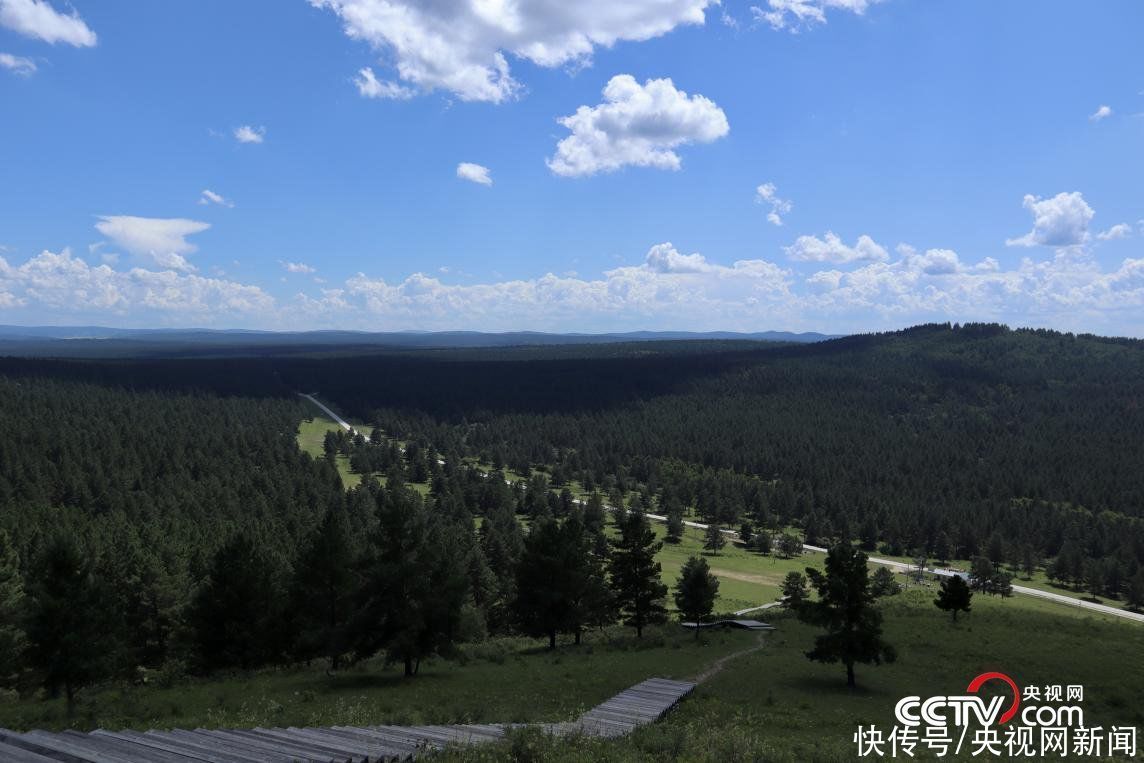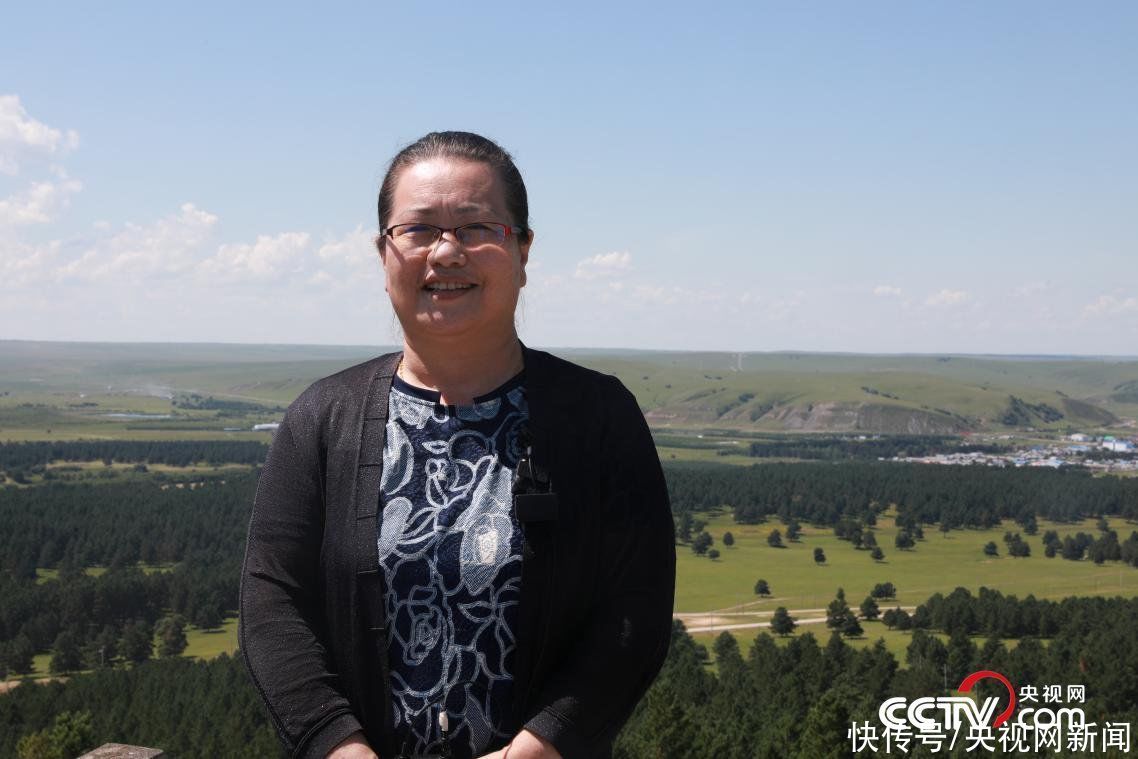CCTV News(Reporter Wang Jingyuan, Peng Jun, Yu Xiaodan): Walking into Honghuaerji Zhangzipine National Forest Park, the first thing you see It is an ornamental stone that reads “Hometown of Pinus sylvestris – Honghua Erji”.
Honghuaerji Pinus sylvestris National Forest Park is located in the Ewenki Autonomous Banner of Hulunbuir City, Inner Mongolia Autonomous Region, and is located in Honghuaerji Forestry Bureau Honghuaerji Forest Farm Shiye The area, with a total area of 6,726 hectares, is dominated by the evergreen sandy pine system and the vast grassland wetland landscape.

Safflower’erji Pinus sylvestris National Forest Park CCTV reporter Wang Jingyuan Photo
There is not only Asia’s largest and my country’s only contiguous sandy pine forest belt, but also rivers, lakes, rich species resources, dynamic There are many kinds of plants, and it is adjacent to the vast Ewenki grassland and Balhu grassland.
Safflower’erji Pinus sylvestris National Forest Park is a national 4A-level scenic spot. On the travel social sharing website, many tourists have listed this place as one of the must-visit places in Hulunbuir.
Get rich without cutting down trees
Relying on commercial logging of natural forests in the past, Up to now, the development of the characteristic under-forest economy and the realization of “getting rich without cutting down trees”, the successful transformation of this small town at the western foot of the Greater Khingan Mountains has witnessed the miracles created by generations of foresters with their wisdom and strength.
From the late 1980s to the early 1990s, under the special historical background of “grain as the key link”, in order to ensure national food security and solve the problem of food and clothing, the surrounding areas of the Daxing’an Mountains in Inner Mongolia were The area began to cultivate food crops in the forest glades and forest margins, and the cultivated land in Ewenki Banner was basically formed during this period.
Ewenki grassland is the core area of Hulunbuir grassland and a key ecological function area. Precipitation was only 350 mm. Large-scale desertification and degradation of the reclaimed forests and grasslands formed in the history of land reclamation, the land status and water resources can no longer support extensive agricultural production, seriously endangering the ecological balance of the Greater Khingan Mountains and surrounding areas, and becoming a new ecological security problem.
A campaign of returning forests to grasslands and saving green begins.
Wang Quanqi, 50 years old this year, is the captain of the professional forest fire brigade of the Honghuaerji Forestry Bureau and a forest ranger. His daily work is mainly afforestation and fire fighting. Speaking of the changes in his hometown over the years, he said that the most intuitive feeling is that “the forest has become larger and there have been more tourists”.

Wang Quanqi, CCTV reporter Yu Xiaodan em>
According to reports, since 2015, Honghuaerji Forestry Bureau has completed various afforestation tasks of 22,000 hectares, including 18,800 hectares of artificial afforestation, 3,200 hectares of closed mountains and 1.22 million hectares of voluntary tree planting. Ten thousand trees, the voluntary tree planting base has formed a scale. The forest coverage rate has also increased from 3% in 1956 to 41.66% today, achieving continuous growth in both the area and stock of forest resources.
Faced with the new opportunity of completely stopping commercial logging of natural forests and reforming state-owned forest areas, Honghuaerji Forestry Bureau focuses on creating advantageous industries dominated by forest eco-tourism, Actively develop forest eco-tourism projects, improve the tourism infrastructure of forest parks, establish ecological picking gardens, and explore forestry industry development models suitable for the region.
The implementation of a series of measures not only protects the ecology, but also extends the forestry industry chain. The development of the local economy has further enhanced the ecological protection awareness of the workers and the masses.

Photo by Meng Jiashu, the hometown of Pinus sylvestris< /em>
Technology holds up the ecological “protective umbrella”
Pine sylvestris is now a national second-class precious Protecting tree species, it has the characteristics of windbreak and sand fixation, drought resistance and barren resistance, and has strong natural regeneration ability.
Pine sylvestris in the sandy land is an important ecological defense line at the southern end of the Hulunbuir Sandy Land and an important guarantee area for national ecological security, as well as an important national carbon storage base, responsible for ensuring the continuous growth of forest resources historical task.
Safflower’erji Forestry Bureau’s National Pine sylvestris Base Protection Station Director Zhu Xiaomei introduced that the Honghuaerji Forestry Bureau currently has nearly 100,000 mu of seed-collecting forests and mother forests Among them, the national key mother forest base is 14,900 mu. Since 2010, more than 5,500 kilograms of improved seeds have been produced, about 1,100 mu of seedlings can be grown, and about 800,000 to 1.2 million mu of desertification can be used for afforestation.
“Our work is the production and breeding of Pinus sylvestris forest trees and seedlings and the genetic improvement of tree species, mainly on the introduction, promotion and application of forest tree breeding technology.”

Photo by Zhu Xiaomei CCTV reporter Peng Jun
Zhu Xiaomei said that as the country entered a new era of ecological priority and green development, she and her colleagues shouldered a heavier burden. Research and cultivate breeding materials with stronger stress resistance and higher genetic gain, so as to realize the creation of new germplasm and new varieties and the popularization and use of improved varieties.
At present, the base has developed high genetic value122 pieces of garden construction materials were collected, 309 acres of sylvestris pine seed orchards were built, and the “Evaluation of Pinus sylvestris genetic resources of different generations” was carried out in cooperation with experts. In addition, a demonstration forest for improved varieties, a test forest for progeny determination, and a conservation forest for germplasm resources have been established, and a fully functional breeding base for improved varieties of Pinus sylvestris has been initially formed.
“The first thing I do when I wake up in the morning is to go for a walk in the forest area on a motorcycle.” Wang Quanqi started his day as a patrol in the forest area. He knew the conditions of the forest area for which he was responsible. “You won’t get lost even at night,” he quipped.
The management personnel including Wang Quanqi are the tip of the forest management system in the forest area. In order to combat and investigate all kinds of behaviors that damage forest resources, Honghuaerji Forestry Bureau has established a five-level forest management and protection system of “Forestry Bureau → Forest Farm → Central Management and Protection Station → Management and Protection Station → Management and Protection Personnel”, and signs responsibility for each layer. Status and Custody Agreement.
In addition, the Forestry Bureau also implements the GPS track management mode, equips the management personnel with GPS satellite navigators and other equipment, and transfers the GPS patrol track of the management personnel to the topographic forest phase. On the map, post-statistics are made on the patrol data to truly reflect the patrol’s forest classes, routes, patrol time and mileage and other data, establish quantitative assessment indicators for the management and protection work, and promote the initiative and consciousness of the management and protection work.

Photographed by Meng Jiashu, the hometown of Pinus sylvestris< /em>
“My father is an old worker in the forest area, and I have a very deep affection for the pine pine.” As a native of Honghua Erji, Wang Quanqi has experienced the transformation of his hometown firsthand. And transformation, and the vast forests he has walked through for decades also witnessed the hard work and silent dedication of generations of foresters.